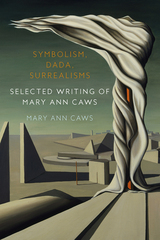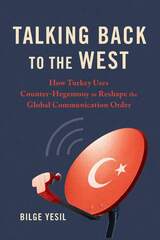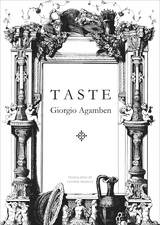101 books about Grammar & Punctuation and 6
start with M
101 books about Grammar & Punctuation and 6
101 books about Grammar & Punctuation
6 start with M start with M
6 start with M start with M
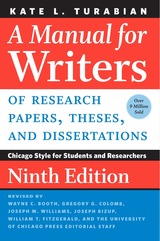
A Manual for Writers of Research Papers, Theses, and Dissertations, Ninth Edition
Chicago Style for Students and Researchers
Kate L. Turabian
University of Chicago Press, 2018
When Kate L. Turabian first put her famous guidelines to paper, she could hardly have imagined the world in which today’s students would be conducting research. Yet while the ways in which we research and compose papers may have changed, the fundamentals remain the same: writers need to have a strong research question, construct an evidence-based argument, cite their sources, and structure their work in a logical way. A Manual for Writers of Research Papers, Theses, and Dissertations—also known as “Turabian”—remains one of the most popular books for writers because of its timeless focus on achieving these goals.
This new edition filters decades of expertise into modern standards. While previous editions incorporated digital forms of research and writing, this edition goes even further to build information literacy, recognizing that most students will be doing their work largely or entirely online and on screens. Chapters include updated advice on finding, evaluating, and citing a wide range of digital sources and also recognize the evolving use of software for citation management, graphics, and paper format and submission. The ninth edition is fully aligned with the recently released Chicago Manual of Style, 17th edition, as well as with the latest edition of The Craft of Research.
Teachers and users of the previous editions will recognize the familiar three-part structure. Part 1 covers every step of the research and writing process, including drafting and revising. Part 2 offers a comprehensive guide to Chicago’s two methods of source citation: notes-bibliography and author-date. Part 3 gets into matters of editorial style and the correct way to present quotations and visual material. A Manual for Writers also covers an issue familiar to writers of all levels: how to conquer the fear of tackling a major writing project.
Through eight decades and millions of copies, A Manual for Writers has helped generations shape their ideas into compelling research papers. This new edition will continue to be the gold standard for college and graduate students in virtually all academic disciplines.
This new edition filters decades of expertise into modern standards. While previous editions incorporated digital forms of research and writing, this edition goes even further to build information literacy, recognizing that most students will be doing their work largely or entirely online and on screens. Chapters include updated advice on finding, evaluating, and citing a wide range of digital sources and also recognize the evolving use of software for citation management, graphics, and paper format and submission. The ninth edition is fully aligned with the recently released Chicago Manual of Style, 17th edition, as well as with the latest edition of The Craft of Research.
Teachers and users of the previous editions will recognize the familiar three-part structure. Part 1 covers every step of the research and writing process, including drafting and revising. Part 2 offers a comprehensive guide to Chicago’s two methods of source citation: notes-bibliography and author-date. Part 3 gets into matters of editorial style and the correct way to present quotations and visual material. A Manual for Writers also covers an issue familiar to writers of all levels: how to conquer the fear of tackling a major writing project.
Through eight decades and millions of copies, A Manual for Writers has helped generations shape their ideas into compelling research papers. This new edition will continue to be the gold standard for college and graduate students in virtually all academic disciplines.
- Bestselling, trusted, and time-tested advice for writing research papers
- The best interpretation of Chicago style for higher education students and researchers
- Definitive, clear, and easy to read, with plenty of examples
- Shows how to compose a strong research question, construct an evidence-based argument, cite sources, and structure work in a logical way
- Essential for anyone interested in learning about research
- Everything any student or teacher needs to know concerning paper writing
[more]
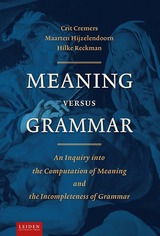
Meaning Versus Grammar
An Inquiry into the Computation of Meaning and the Incompleteness of Grammar
Crit Cremers
Amsterdam University Press
Meaning versus Grammar investigates the complicated relationship between grammar, computation, and meaning in natural languages. It details conditions under which meaning-driven processing of natural language is feasible, discusses an operational and accessible implementation of the grammatical cycle for Dutch, and offers analyses of a number of further conjectures about constituency and entailment in natural language.
[more]
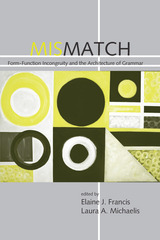
Mismatch
Form-Function Incongruity and the Architecture of Grammar
Edited by Elaine J. Francis and Laura A. Michaelis
CSLI, 2002
Linguistic mismatch phenomena involve semiotic functions that attach to forms in defiance of grammatical design features. Noun phrases, when used as predicates, provide one example: how do predicate nominals correspond to our theories of what nouns mean? How do such phenomena challenge traditional conceptions of grammar? How do competing theories of the syntax-semantics interface stand up when confronted with mismatch phenomena? Mismatch addresses these questions through the efforts of some of the most original thinkers in syntactic and semantic theory, exploring a wide variety of mismatch phenomena in a broad sampling of languages.
[more]
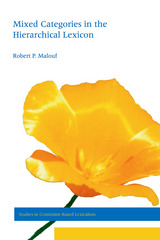
Mixed Categories in the Hierarchical Lexicon
Robert P. Malouf
CSLI, 2000
Mixed category constructions like the English verbal gerund involve words that seem to be central members of more that one part of speech. This poses a problem for the standard view of syntactic categories.
This book presents a novel analysis of this and similar mixed category constructions in languages including Quechua, Tibetan, Arabic, Fijian, Dagaare, and Jacaltec. Under this analysis, Robert P. Malouf shows that verbal gerunds share the selectional properties of verbs and the distributional properties of nouns. He further shows that since different dimensions of grammatical information can vary independently, the behavior of mixed categories creates no paradox. These dimensions are in principle independent. However, certain types of mixed categories are quite common in the world's languages, while others are rare or nonexistent. The book discusses how cross-linguistic variation can be accounted for by a lexical categorial prototype. By stating these prototypes as default constraints in a hierarchy of lexical information, Malouf argues that one can bring insights from cognitive and functional approaches to linguistics into a formal analysis, thus building on the strengths of both approaches.
This book presents a novel analysis of this and similar mixed category constructions in languages including Quechua, Tibetan, Arabic, Fijian, Dagaare, and Jacaltec. Under this analysis, Robert P. Malouf shows that verbal gerunds share the selectional properties of verbs and the distributional properties of nouns. He further shows that since different dimensions of grammatical information can vary independently, the behavior of mixed categories creates no paradox. These dimensions are in principle independent. However, certain types of mixed categories are quite common in the world's languages, while others are rare or nonexistent. The book discusses how cross-linguistic variation can be accounted for by a lexical categorial prototype. By stating these prototypes as default constraints in a hierarchy of lexical information, Malouf argues that one can bring insights from cognitive and functional approaches to linguistics into a formal analysis, thus building on the strengths of both approaches.
[more]
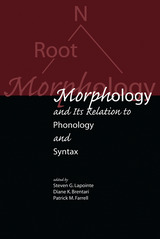
Morphology and its Relation to Phonology and Syntax
Patrick Farrell
CSLI, 1998
Leading experts in the field have contributed to this volume which explores key issues in current morphology and the interactions of morphology with phonology and syntax. Included here are papers on compounding, argument structure, voice systems, agreement marking, movement of constituents in compounds and derived forms, haplology, affix realization, stem selection and allomorphy, levels in phonology- morphology interactions, and nonisomorphism across grammatical components. These topics are considered from a variety of theoretical perspectives, among them the theory of Lexical Conceptual Structure, the Principles and Parameters framework, Lexical Functional Grammar, Autolexical Syntax, Optimality Theory, Distributed Morphology, Paradigm-Based Realizational Morphology, and the theory of Cophonologies.
[more]
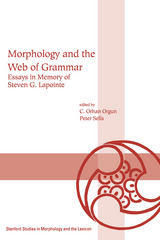
Morphology and the Web of Grammar
Essays in Memory of Steven G. Lapointe
Edited by C. Orhan Orgun and Peter Sells
CSLI, 2003
This collection presents papers in memory of Steven G. Lapointe, a distinguished professor of linguistics at the University of California, Davis, at the time of his death in 1999. Lapointe's work on morphology and its connection to other linguistic subfields was the basis of a workshop held at UC Davis in 2000. This selection of papers from that workshop discusses the relationship of morphology to phonology, syntax, and semantics, as well as the details of modern morphological theory—forming a natural continuation of the intellectual developments in Lapointe et al.'s Morphology and Its Relation to Phonology and Syntax.
[more]
READERS
Browse our collection.
PUBLISHERS
See BiblioVault's publisher services.
STUDENT SERVICES
Files for college accessibility offices.
UChicago Accessibility Resources
home | accessibility | search | about | contact us
BiblioVault ® 2001 - 2024
The University of Chicago Press


